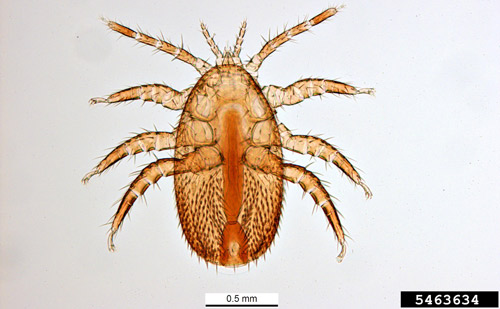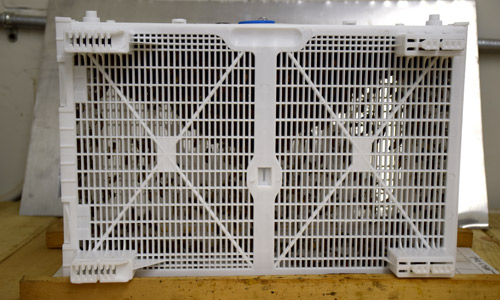common name: Tropilaelaps mite
scientific name: Tropilaelaps spp. Delfinado & Baker (Arachnida: Mesostigmata: Laelapidae)
Introduction - Hosts - Distribution - Description - Life Cycle - Detection - Economic Importance -Management - Selected References
Introduction (Back to Top)
Honey bees throughout the world are exposed to numerous pests, parasites, and pathogens. One such parasite is Tropilaelaps spp. Delfinado & Baker (Acari: Laelapidae). Tropilaelaps is an ectoparasitic mite that feeds on the hemolymph of developing honey bees.
Four species of Tropilaelaps have been identified and characterized: Tropilaelaps clareae, Tropilaelaps koenigerum, Tropilaelaps mercedesae and Tropilaelaps thaii.
Figure 1. Adult female Tropilaelaps. Figure by the Pest and Diseases Image Library, Bugwood.org
Hosts (Back to Top)
The giant Asian honey bee, Apis dorsata, is Tropilaelaps’ primary host. However Tropilaelaps may also be found in the colonies of other Asian honey bee species including Apis cerana and Apis florae. The western honey bee, Apis mellifera L., is not a natural host for of Tropilaelaps. However, western honey bees are parasitized by Tropilaelaps in regions where both species are present. Unfortunately the western honey bee lacks the behavioral defenses that Asian honey bee species have evolved to combat severe Tropilaelaps infestations.
Distribution (Back to Top)
Tropilaelaps is a native pest in tropical and subtropical Asia. However, Tropilaelaps’ distribution has been expanding over the past 50 years. Tropilaelaps can been found in Apis mellifera colonies well beyond the mite’s native range. Invasive Tropilaelaps populations are most successful in warm environments where honey bees produce brood (developing larvae or pupae) throughout the year. For instance, Tropilaelaps have been reported in Kenya and Papua New Guinea.
Description (Back to Top)
Eggs: A physical description of Tropilaelaps eggs is not available.
Nymphs: In general, Tropilaelaps nymphs are not pigmented and are smaller than adults. Nymphs have three pairs of legs, and the first pair is longer than the second and third pairs.
Adults: Tropilaelaps adults are elongated with a heavily sclerotized exoskeleton. The bodies of both sexes are covered with numerous, short, spine-like hairs and are generally a reddish brown color (Figure 1). Tropilaelaps females are approximately 0.7-1.0 mm long and 0.5-0.6 mm in width, while males are significantly smaller. Adult mites have four pairs of legs. Morphologically Tropilaelaps differ from another parasitic mite, Varroa spp. Oudemans, in both size and shape. Tropilaelaps are smaller and have narrow/long bodies whereas Varroa are larger in size and are wider than long (Figure 2).
Figure 2. Varroa on the left, compared with Tropilaelaps on the right. Photograph by Zachary Huang, www.beetography.com.
Life Cycle (Back to Top)
Much of the Tropilaelaps life cycle takes place beneath the wax capping of a honey bee brood cell. Therefore, several aspects of their reproduction are unknown. A mated female Tropilaelaps that is ready to produce offspring (foundress mite) enters a honey bee brood cell just before it is capped, while the honey bee is still a larva. Each foundress lays approximately three to four eggs within the cell after the cell is capped. Twelve hours later, Tropilaelaps nymphs hatch and feed on the developing honey bee larva/pupa. Tropilaelaps infect both worker and drone brood, and develop from egg to adult within a week. Adult mites emerge from the brood cell when the adult honey bee emerges. At this point, the females search for additional honey bee larvae to infect.
It generally is believed that adult Tropilaelaps mate in the capped honey bee brood cell before emerging (similar to Varroa). However, some believe that adult mites may mate once they have emerged from the honey bee brood cell.
Tropilaelaps have small mouth parts that are unable to pierce the integument (skin) of adult honey bees. Therefore, both nymph and adult Tropilaelaps must feed on the hemolymph of the honey bee brood. After emerging from the honey bee brood cell, adult Tropilaelaps must reenter another brood cell to feed on a developing bee or the mite will die within two days. Tropilaelaps have a short reproductive cycle and possess the potential for rapid population growth. Furthermore, their rapid reproduction enables Tropilaelaps to outcompete Varroa in honey bee colonies infected by both mites.
Tropilaelaps are transported inside and outside of the honey bee colony by the adult honey bees. Phoretic mites (mites attached to an adult honey bee) can be transported throughout the colony’s brood combs or into another colony when adult bees drift into another colony, rob resources from other colonies, or swarm. Beekeeping management techniques, such as movement of infested combs and/or bees between colonies, can spread Tropilaelaps.
Detection (Back to Top)
Tropilaelaps infestation is evident from visible colony symptoms such as irregular brood patterns, perforated brood cell cappings, and newly emerged bees with misshaped abdomens, irregular wings and distorted or missing legs. In severe cases, Tropilaelaps infestations may cause the colony to abscond (the honey bee colony abandons the brood and hive) or even die.
Several methods exist for detecting Tropilaelaps infestation. One rapid, easy, and effective technique is the “bump” method. To collect mites using the bump method you: 1) remove a frame of capped brood from the colony, 2) shake adult bees off the surface of the comb, 3) firmly bump (hit) one side of the frame over a white surface, 4) turn the frame over and bump again, 5) repeat steps 3 and 4 so that you conduct a total of four bumps (2 bumps each side), 6) then quantify the Tropilaelaps present on the white surface. It is important to remember that Tropilaelaps are small and fast moving. It is recommended that a pan be used as the white surface, this will help contain the dislodged mites.
Economic Importance (Back to Top)
Due to a high reproductive rate and quick development time, populations of Tropilaelaps can grow rapidly. This rapid build-up makes this parasite difficult to manage. Tropilaelaps can cause significant mortality of the honey bee brood. In severe cases, up to 50% of a honey bee colony’s brood may be killed by Tropilaelaps, and colonies may have so much dead brood that the smell of decaying remains is apparent. Brood patterns may be irregular and may contain areas of neglected brood along with cell cappings that have been perforated. Tropilaelaps parasitism during the larval and pupal stages often results in reduced lifespans of adult bees. In addition to shorter lifespans, these parasitized honey bees may have lower body weights as well as shrunken or deformed wings and legs.
Tropilaelaps is considered a potential threat to the honey bee industry throughout the world because this mite has the potential to thrive in any tropical/subtropical region that hosts honey bees. In countries like the United States and Australia, Tropilaelaps could cause colony losses and reduce the viability of the commercial beekeeping industry.
Management (Back to Top)
Widely recommended beekeeping management strategies for Tropilaelaps include: regular re-queening with hygienic queenlines and use of modified bottom boards. Cultural control methods involving caging queens have been successful in treating Tropilaelaps infestations. A colony’s Tropilaelaps population can be reduced greatly if a colony is made broodless for a sufficient period of time by caging the queen for nine days and removing the mature capped brood. It is likely that many of the miticides used against Varroa in the U.S. are efficacious against Tropilaelaps.
Strict monitoring programs have been established throughout the world to prevent further spread of Tropilaelaps beyond its native range. Any transportation of honey bees from an area infested with Tropilaelaps to a region that does not have Tropilaelaps should be done using packages (adult bees only- no comb) rather than established colonies (Figure 3). These packages should be stored away from any honey bee colonies for a minimum of two days. Following a two day hold, any Tropilaelaps that may have been transported within the package will be dead because there is no brood in a package to support mite feeding.
Figure 3. A package of honey bees. Note that no wax comb or brood is present within a package of bees. Only adult honey bees and one queen are contained within a package. Any phoretic Tropilaelaps will die within two days. This is the recommended practice for transporting honey bees from an area infested with Tropilaelaps to a region that does not have Tropilaelaps. Photograph by Brandi Simmons, University of Florida.
Selected References (Back to Top)
- Anderson DL, Roberts JMK. 2013. Standard methods for Tropilaelaps mites research. In Volume II: Standard Methods for Apis mellifera Pest and Pathogen Research, The Coloss BeeBook, Eds. Dietemann V, Ellis JD, Neumann P. Journal of Apicultural Research 52: http://dx.doi.org/10.3896/ibra.1.52.4.21.
- Burgett M, Akratanakul P, Morse RA. 1983. Tropilaelaps clareae: A parasite of honeybees in south-east Asia. Bee World 64: 25-28.
- DeBerry S, Crowley J, Ellis JD. 2012. Swarm control for managed beehives. University of Florida, IFAS, Electronic Data Information Source, ENY-160. (19 July 2013).
- Delfinado MD, Baker EW. 1961. Tropilaelaps, a new genus of mite from the Philippines (Laelapidae: Acarina). Fieldiana-Zoology 44: 53-56.
- Delfinado-Baker M, Baker EW. 1982. A new species of Tropilaelaps parasitic on honeybees. American Bee Journal 112: 416-417.
- Ellis JD, Munn PA. 2005. The worldwide health status of honey bees. Bee World 86(4): 88-101.
- Ellis JD, Zettel Nalen CM. 2013. Varroa destructor Anderson and Trueman (Arachnida: Acari: Varroidae). University of Florida, IFAS, Entomology and Nematology Department, Featured Creatures, EENY-473. (29 July 2014).
- Mahmood R, Mohsin AU, Asad S, Raja S, Sarwar G. 2014. Integrated control of Tropilaelaps clareae and Varroa destructor in Apis mellifera L. colonies. Journal of Agricultural Science 4: 32-37.
- Matheson A. 1997. Country records for honeybee diseases, parasites and pests. Appendix 11. In Honeybee Pests, Predators and Diseases, 3rd edition, Eds. Morse RM, Flottum PK. A. I. Root, Medina OH, USA. pp. 586-602.
- Mortensen AN, Schmehl DR, Ellis JD. 2013. Apis mellifera Linnaeus, and subspecies (Insecta: Hymenoptera: Apidae). University of Florida, IFAS, Entomology and Nematology Department, Featured Creatures, EENY 568. (29 July 2014).
- Pettis JS, Rose R, Lichtenberg EM, Chantawannakul P, Buawangpong N, Somana W, Sukumalanand P, Vanengelsdorp D. 2013. A rapid survey technique for Tropilaelaps mite (Mesostigmata: Laelapidae) detection. Journal of Economic Entomology 106: 1535-1544. doi: http://dx.doi.org/10.1603/EC12339
- Ritter W. 2014. Tropilaelaps infestation of honey bees (Tropilaelaps spp.) In: Manual of Diagnostic Tests and Vaccines for Terrestrial Animals. World Organization for Animal Health, Paris, France. pp. 420-423.
- Tangkanasing P, Wongsiri S, Vongsamanode S. 1988. Integrated control of Varroa jacobsoni and Tropilaelaps clareae in bee hives in Thailand. In: Africanized Honey Bees and Bee Mites. Eds.Needham GR, Page RE, Delfinado-Baker M, Bowman CE. Ellis Horwood Ltd,Chichester, West Sussex, England, pp 409-441.
- Woo KS, and Lee JH. 1997. Current status of honeybee mites in Korea. Honeybee Science 18: 175-177.
- Woyke J. 1994. Mating behavior of the parasitic honeybee mite Tropilaelaps clareae. Journal of Experimental and Applied Acarology 18: 723-733. doi: http://dx.doi.org/10.1007/BF00051539.


